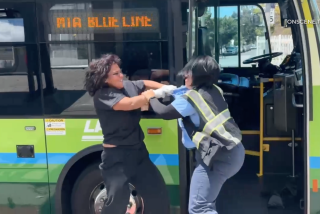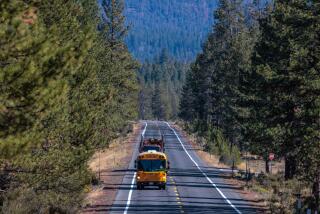Safety Belts in School Buses Offer No Help, NTSB Says : Health: Federal agency says seats should be redesigned instead. Study follows California bill mandating restraints.
- Share via
WASHINGTON — Parents wondering whether seat belts would make their children safer on school buses got an unexpected answer from a federal watchdog agency on Tuesday.
Lap and shoulder belts provide no added benefit for the 23 million kids who ride the nation’s school buses--and can even cause unintended harm in certain severe crashes--the National Transportation Safety Board concluded after an 18-month study.
A computer re-creation of three recent truck-bus collisions found that school bus seats are too flat and slippery to make seat belts effective. In fact, in some cases, securing kids in their seats only made their heads snap dangerously back and forth.
The board recommended instead that the seats be redesigned to make them safer for kids in all types of crashes. It left open the issue of whether seat belts should be part of those next-generation school bus seats.
“The [current] seats are not designed for seat belts and that’s the bottom line,” said Joe Osterman, head of the safety board’s highway division.
The board’s findings raise doubts about the benefit of a law passed by the California Legislature earlier this month. It would make the state the first to require lap and shoulder belts on new school buses, beginning in 2002. A spokeswoman for Gov. Gray Davis said that the governor, who has not yet signed the bill, will review the latest developments.
With every state requiring parents to buckle up young children in family cars, a growing movement of parents, pediatricians and safety advocates has been campaigning for seat belts on school buses, arguing that society is sending children a mixed message. Florida and Louisiana recently decided to mandate lap belts on school buses, as New Jersey and New York have for years.
Dr. Marilyn Bull, an Indianapolis pediatrician and prominent child safety advocate, said that seat belts should not be ruled out. “The most compelling reason is the behavioral issue,” said Bull. “There is a value to consistency. Children are expected to be buckled up in the family car. They get on an airplane and they have to wear a seat belt. They get on a school bus and there’s nothing. It makes no sense.”
Assemblyman Martin Gallegos (D-Baldwin Park), sponsor of the California bill, said that the federal government has been slow to develop safety standards for children in school buses.
The Legislature has “worked on this for a couple of years and we reached a consensus and we felt we wanted to move ahead,” Gallegos said. Nearly 2 million children ride school buses in California.
Safety board chairman James E. Hall said that states should wait for a new seat design before requiring seat belts. “We do not want to repeat the mistake that was made with air bags,” said Hall. About 70 children have been killed by the safety devices in the 1990s.
Adding belts to the present style of school bus seats would add about $2,000 to the price of the average $60,000 bus, according to the industry. There are no estimates of what a new seat design would cost.
Even though school buses do not have seat belts, they are the safest form of road transportation.
Nationally, an average of nine school bus passengers are killed every year. In California, only three students were killed this decade, although injuries average about 700 a year.
The injury statistics are what prompted the Legislature to act. From 1977 to 1998, the number of school bus crashes increased by 23%--but the number of injured pupils more than doubled.
School buses rely on closely spaced, high-backed, padded seats to keep children from being tossed about in a crash. This design takes the place of seat belts. More than 20 years old, it is called “compartmentalization.” The National Highway Traffic Safety Administration--another federal agency that sets vehicle safety standards--requires all school buses to be built according to this design concept.
The safety board’s investigation found that the compartment design works well in frontal crashes but not in side crashes or rollovers. In these accidents students can be flung into the aisles and through windows.
However, seat belts turned out not to be the answer to this problem.
Using computer models, the board staff re-created accidents in Colorado, Minnesota and New Jersey. All involved serious high-speed crashes between a bus and a truck. The computer modeled three scenarios: unbelted children, children wearing lap belts and children wearing lap and shoulder belts.
Videos dramatically simulated what happened inside the buses, in a real-world time span of less than one second. Unbelted children flew into the aisles, crashing into seats and other children.
But the belted children fared no better in the simulation. Their hips, held down by the belts, stayed in place. However, the flat surfaces and vinyl covering of school bus seats allowed their heads, upper bodies and legs to be whipsawed. One simulation showed a child’s body propelled sideways toward the center aisle, with the neck violently bending back over the seat frame.
The simulation also showed that in a severe side impact, a spinning, pitching school bus generates a greater centrifugal force--pushing occupants outward--than would a car. The board’s staff experts said that this could help explain the poor performance of seat belts.
The safety board is an independent watchdog agency that investigates serious transportation and pipeline accidents and recommends improvements to industry and government regulators. It is often critical of Transportation Department agencies like the Federal Aviation Administration and the traffic safety agency.
In addition to the new seat design, the five-member board voted unanimously to recommend on-board recorders for all buses, which would help investigators determine the causes of accidents. The board also recommended new safety standards for commercial buses to strengthen roofs and require windows that will not shatter, thus permitting passengers to be tossed out.
A spokesman for the traffic safety agency had no comment on the board’s recommendations but agreed that installing seat belts on the current generation of buses is not necessary.
“We don’t see any benefits to lap belts and we see a lot of downsides,” said Rae Tyson.
The traffic safety agency is working on a major school bus safety study, which is expected to be completed next summer. School bus manufacturers, although concerned about the cost of safety improvements, have said publicly that they will adopt any science-based recommendations.
More to Read
Get the L.A. Times Politics newsletter
Deeply reported insights into legislation, politics and policy from Sacramento, Washington and beyond. In your inbox twice per week.
You may occasionally receive promotional content from the Los Angeles Times.










